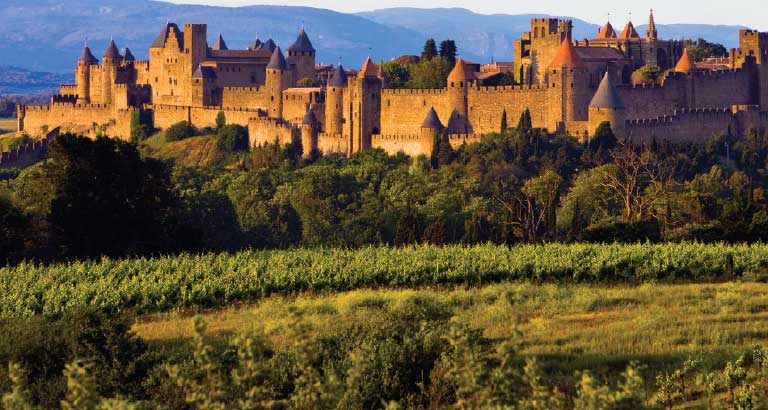
With the holiday season upon us, BTM recommends some of France’s ‘must-visit’ destinations.
CARCASSONNE
A fortified city in the region of Occitanie with a population of around 50,000, the hilltop city is famous for the Cité de Carcassonne, a medieval fortress restored by the theorist and architect Eugène Viollet-le-Duc in 1853 and added to the UNESCO list of World Heritage Sites in 1997.
Inhabited since the Neolithic period, Carcassonne is located in the Aude plain between historic trade routes, linking the Atlantic to the Mediterranean Sea and the Massif Central to the Pyrénées. Great things to do include walking the ramparts of the medieval city, taking in a concert or opera at the Grand Théâtre, enjoying multiple options for fine dining and regional grape or taking a drive just outside the city to Lac de la Cavayère, a lake formed by a dam built in 1988, with 40 hectares of water, pine woodland and small beaches.
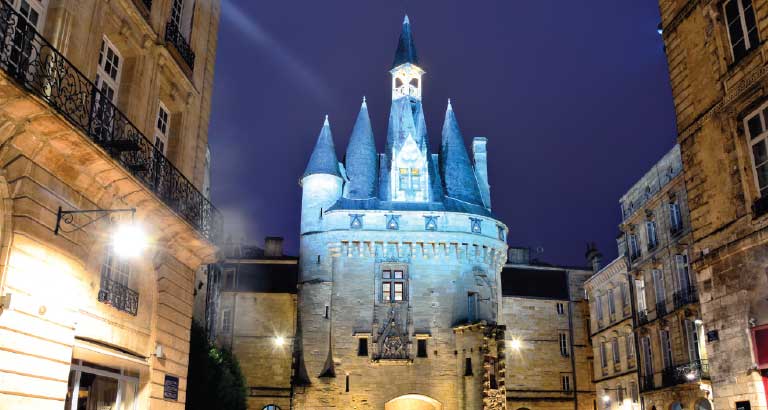 BORDEAUX
BORDEAUX
A familiar name, Bordeaux is the hub of the famed grape-growing region and experiences based around the noble beverage abound. It’s also a foodie paradise where you can take cooking classes, which will often include trips to the area’s bustling fresh-produce markets.
A port city which sits on the Garonne River, it’s known for its Gothic Cathédrale Saint-André, 18th- to 19th-century mansions and notable art museums such as the Musée des Beaux-Arts de Bordeaux. Public gardens line the curving river quays and the grand Place de la Bourse, centred on the Three Graces fountain, overlooks the Miroir d’Eau reflecting pool.
Make sure to visit the Chartrons district, one of the city’s hippest spots, where elegant mansions sit alongside converted warehouses, which are home to chic designer emporia and arts and antique traders.
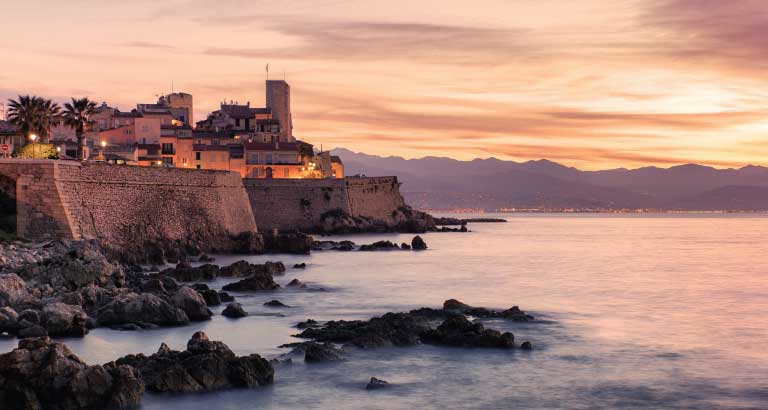 ANTIBES
ANTIBES
Antibes, a resort town between Cannes and Nice on the French Riviera (Côte d’Azur), has serious star-spotting potential since it’s a long-established playground of the rich and famous, known for its old town enclosed by 16th-century ramparts and the star-shaped Fort Carré, which overlooks luxury yachts moored at the Port Vauban marina.
Pay a visit to the Musée Picasso in the Château Grimaldi, which houses a large collection of works donated by the artist himself and his family. And then follow the Trail of Past Artists, marking the spots where many greats have pitched their easels over the years to capture the amazing light and scenery.
The forested Cap d’Antibes peninsula, dotted with grand villas, separates Antibes from Juan-les-Pins, a chic resort with buzzing nightlife and the Jazz à Juan music festival. If you’re heading to the cap, make sure to take in the Hotel du Cap-Eden-Roc, one of the most luxurious hotels in the world and worth a visit, even if just for a look or to enjoy a drink or a spa visit.
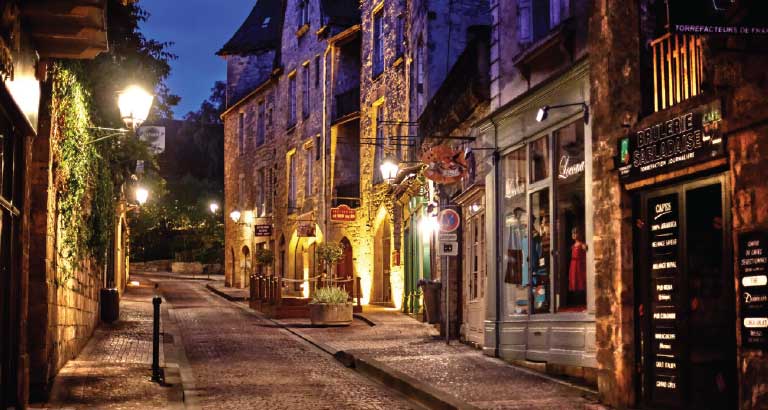 DORDOGNE
DORDOGNE
Set between the Loire Valley and Pyrénées mountains, the Dordogne is known for prehistoric cave paintings in the Vézère Valley, like those in Lascaux Cave. There are cave complexes across the region and breathtaking landscapes of stalagmites and stalactites abound.
The region is also known for its numerous castles, such as the Château de Hautefort, one of the Dordogne’s most prestigious castles which underwent major renovations only to be destroyed by fire in 1968 and then brought back to its present-day glory.
The town of Périgueux is home to the Cathédrale St-Front, with its five domes, and the Vesunna Museum, built around Roman ruins. And a trip to the medieval Sarlat-la-Canéda is a must. The most famous town in the region, it centres on the Rue de la République with mazes of narrow streets running off on either side, where you will find shops and restaurants selling regional specialities such as truffles.
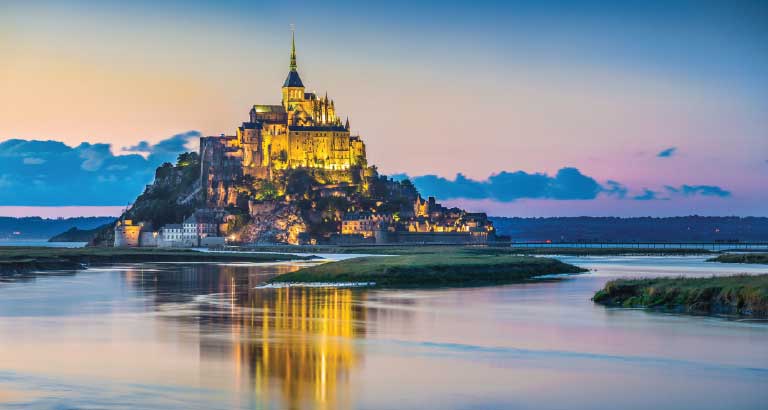 MONT ST MICHEL
MONT ST MICHEL
Get away from it all with a trip to this island commune in Normandy, located about a kilometre off the northwestern coast, at the mouth of the Couesnon River near Avranches.
The island is accessible at low tide to the many pilgrims who visit its abbey, but, with the incoming waves, it is cut off, making it a hugely important defensible position during its heyday – in fact, with just a small garrison, it withstood a full attack by the English in 1433.
One of France’s most recognisable landmarks, visited by more than 3 million people each year, Mont-Saint-Michel and its bay are on the UNESCO list of World Heritage Sites. Its steep streets are home to chic hotels, restaurants, museums and galleries.
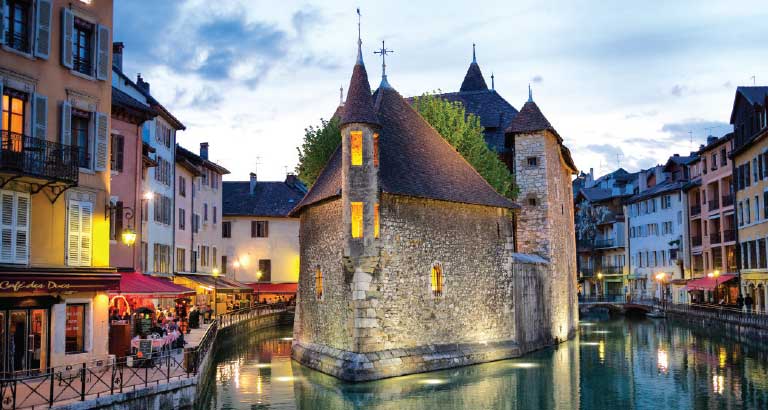 ANNECY
ANNECY
Known as the ‘Pearl of the French Alps’, this is a hidden gem that will not disappoint. Annecy is known for its Vieille Ville (old town), with cobbled streets, winding canals and pastel-coloured houses. Overlooking the city, the medieval Château d’Annecy, once home to the Counts of Geneva, contains a museum with regional artefacts such as alpine furniture and religious art, plus a natural history exhibit.
From river rafting and tubing to parasailing and gliding, the area around the town is a paradise for outdoor sports enthusiasts. But, if you’re feeling less energetic, there is plenty of interest to explore, such as the local castle, Jardins de l’Europe – a municipal park in truly stunning surroundings – and the Pont des Amours, which spans the Vassé canal – legend says that lovers who kiss on the bridge will be together forever. Don’t forget to pose for a picture on the famous Palais de l’Isle, which sits in the middle of the Canal du Thiou.
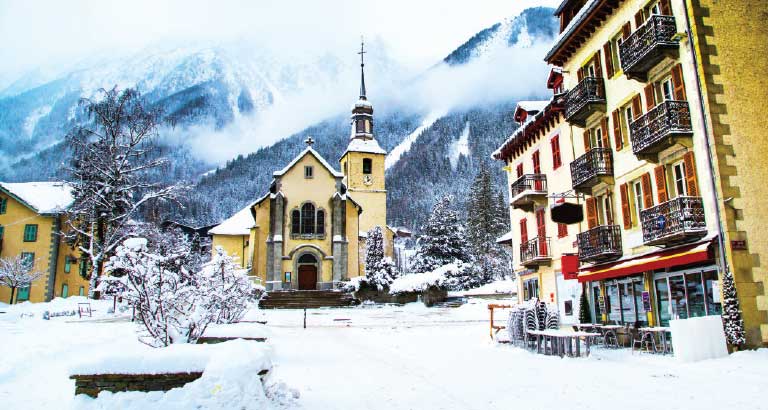 CHAMONIX
CHAMONIX
As our temperature rises, the idea of snow-capped mountains, hot chocolate, cheese fondue and mulled grape becomes more and more appealing. If you agree, then Chamonix may be the spot for you. Located in the heart of the Rhônes Alpes region, the town is bustling with life and a huge favourite with winter sports enthusiasts.
lose to the junction of France, Switzerland and Italy, Chamonix is a cosmopolitan resort at the base of Mont Blanc.
The high altitude of the skiing (most pistes are over 2,000m) means that snow is assured through to the end of April. In addition, there is an incredible amount of off-piste and ski-touring terrain that draws experienced skiers and snowboarders from all around the world.
The town’s main attraction is Mont Blanc, the highest mountain in Western Europe at 4,810m. Visitors either come to reach the summit themselves, or view it from the station at the top of the Aiguille du Midi cable car (3,842m). At the top of the Aiguille du Midi, you’ll find ‘Step into the Void’, one of Chamonix’s most recently added attractions. You literally step into a glass-sided box with views of Mont Blanc to your left and a 1,000-metre drop beneath your feet!
Another hugely popular place to visit is the Mer de Glace glacier (the ‘Sea of ice’) which is accessed by the Montenvers train. From the top, you can descend to an ice cave excavated into the glacier via a cable car and a series of walkways and steps. Markers along the rock walls on the descent show you just how much the glacier has retreated in recent years.



